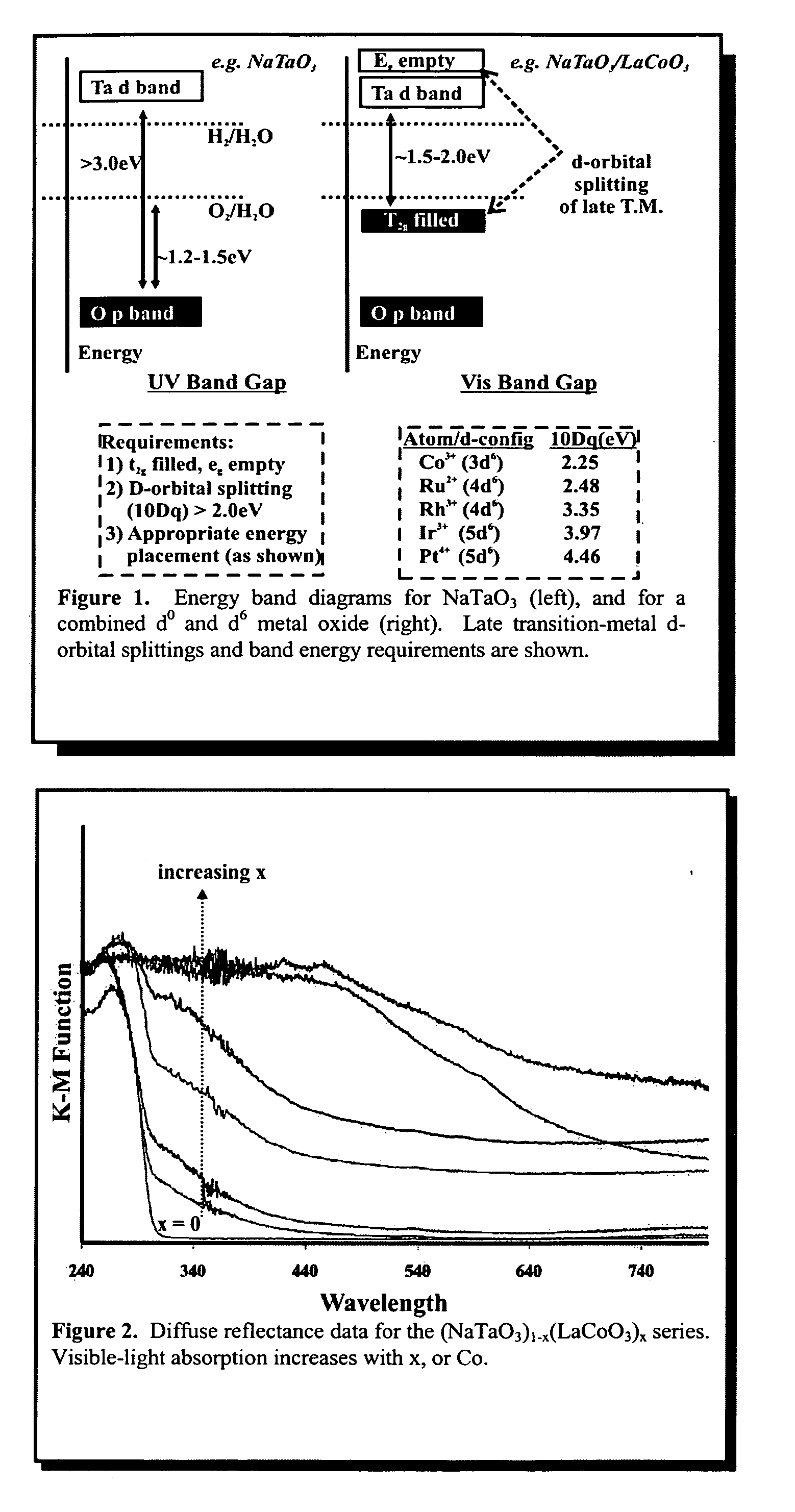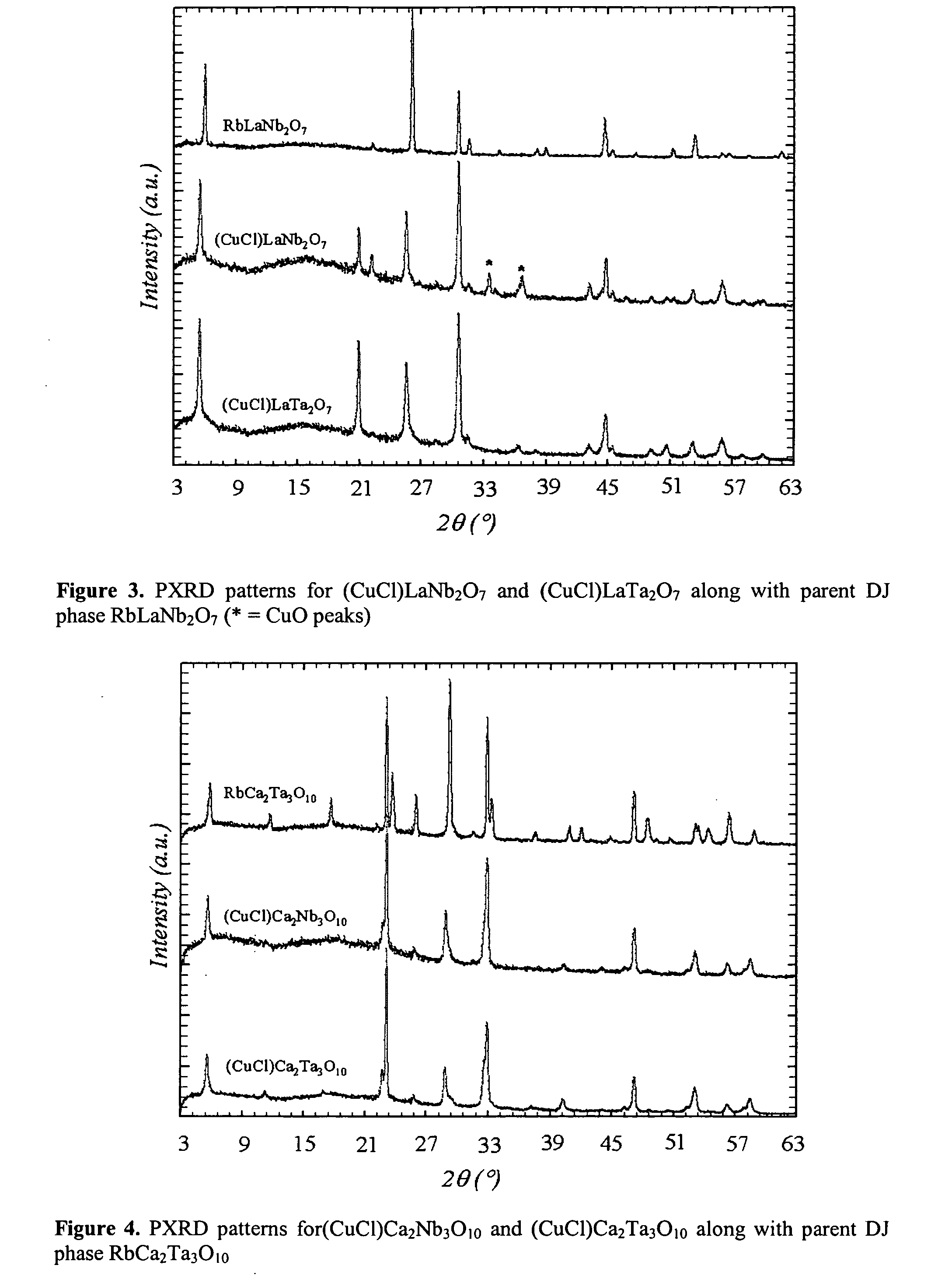Solar photocatalysis using transition-metal oxides combining d0 and d6 electron configurations
a technology of transition metal oxides and photocatalysis, applied in the direction of metal/metal-oxide/metal-hydroxide catalysts, metal/metal-oxide/metal-hydroxide catalysts, energy input, etc., can solve problems such as difficulty in lowering band gaps, and achieve the effect of increasing method efficiency
- Summary
- Abstract
- Description
- Claims
- Application Information
AI Technical Summary
Benefits of technology
Problems solved by technology
Method used
Image
Examples
example 1
Optical and Photocatalytic Data For Two Mixed Ta (d0) and Co(d6) Solid Solutions: (NaTaO3)1−x(LaCoO3)x and (KTaO3)1−x(LaCoO3)x
[0083] i. Syntheses: Presynthesized LaCoO3 was intimately mixed and reacted with stochiometric quantities of Ta2O5 and Na2CO3 or K2CO3, at up to ˜1100° C., to give (NaTaO3)1−x(LaCoO3)x and (KTaO3)1−x(LaCoO3)x perovskite-type solid solutions containing from 0% to 100% LaCoO3. A total of ˜15 different samples were prepared for testing this way, each containing a different Ta:Co ratio. Up to three regrindings and three reheatings were required. All products were monitored using powder X-ray diffraction techniques to ensure a complete reaction and mix of transition metals.
[0084] ii. Optical Absorption Data: The visible-light absorption of each sample was measured using UV-Vis diffuse reflectance techniques. Powdered samples of each product were mounted on a quartz slide with tape, and the optical absorption taken as a function of wavelength. These measurements,...
example 2
Preparation off Photocatalytically-Active Hydrated Forms Of Amorphous Titania, TiO2.nH2O
[0087] Synthesis. Amorphous and hydrated TiO2 was prepared by dissolving a weighed amount of Titanium (IV) n-butoxide (2 g, 0.00588 mol; Alfa Aesar, 99+%) into either pure ethanol (2, 5, 10, or 20 ml), acetone (5 ml), hexane (5 ml), or tetrahydrofuran (5 ml). Each of these solutions was mixed for 10 min and aged at room temperature for 24-48 h, during which time all of the solvent had evaporated and an amorphous white powder was obtained. To remove the remaining organic species, each powder was re-dispersed in 20 ml of deionized water (1:100 solid / water ratio) and dried at 80° C. for 1 h to yield amorphous TiO2.nH2O powders labeled the TiO2-A1 series. Another preparation of amorphous TiO2 was performed by dissolving the Titanium (IV) n-butoxide into 3 ml of concentrated HCl, following by the dropwise addition of concentrated aqueous ammonia with vigorous stirring until the pH of the solution rea...
example 3
Hydrothermal Synthesis of Photocatalytic SrTiO3-Coated Fe2O3 and BiFeO3
[0092] To our knowledge no composite system has been reported whereby a small-bandgap metal oxide, such as Fe2O3 or BiFeO3, has been tested as a visible-light sensitizer in a photocatalytic material such as SrTiO3. Described herein (and also in J. Luo and P. Maggard, Adv. Mater. 2006, 18, 514-517) are the results of a new low-temperature synthesis of a crystalline SrTiO3 coating onto either Fe2O3 or BiFeO3 particles, as well as the characterization of their particle sizes / morphologies, optical absorption, and photocatalytic properties.
[0093] Both Fe2O3 and BiFeO3 were dispersed separately in ethanol in an ultrasonic bath, added to a HNO3 / H2O / CH3CH2OH solution containing TiO2(sol) and aqueous Sr2+, and slowly precipitated with 0.1 M NaOH base to a final pH of 13. The solutions were filtered and heated to 240° C. under hydrothermal conditions to crystallize the SrTiO3 coating, at a 6:1 shell / core molar ratio. The...
PUM
| Property | Measurement | Unit |
|---|---|---|
| Structure | aaaaa | aaaaa |
| Photocatalytic properties | aaaaa | aaaaa |
| Energy | aaaaa | aaaaa |
Abstract
Description
Claims
Application Information
 Login to View More
Login to View More - R&D
- Intellectual Property
- Life Sciences
- Materials
- Tech Scout
- Unparalleled Data Quality
- Higher Quality Content
- 60% Fewer Hallucinations
Browse by: Latest US Patents, China's latest patents, Technical Efficacy Thesaurus, Application Domain, Technology Topic, Popular Technical Reports.
© 2025 PatSnap. All rights reserved.Legal|Privacy policy|Modern Slavery Act Transparency Statement|Sitemap|About US| Contact US: help@patsnap.com


